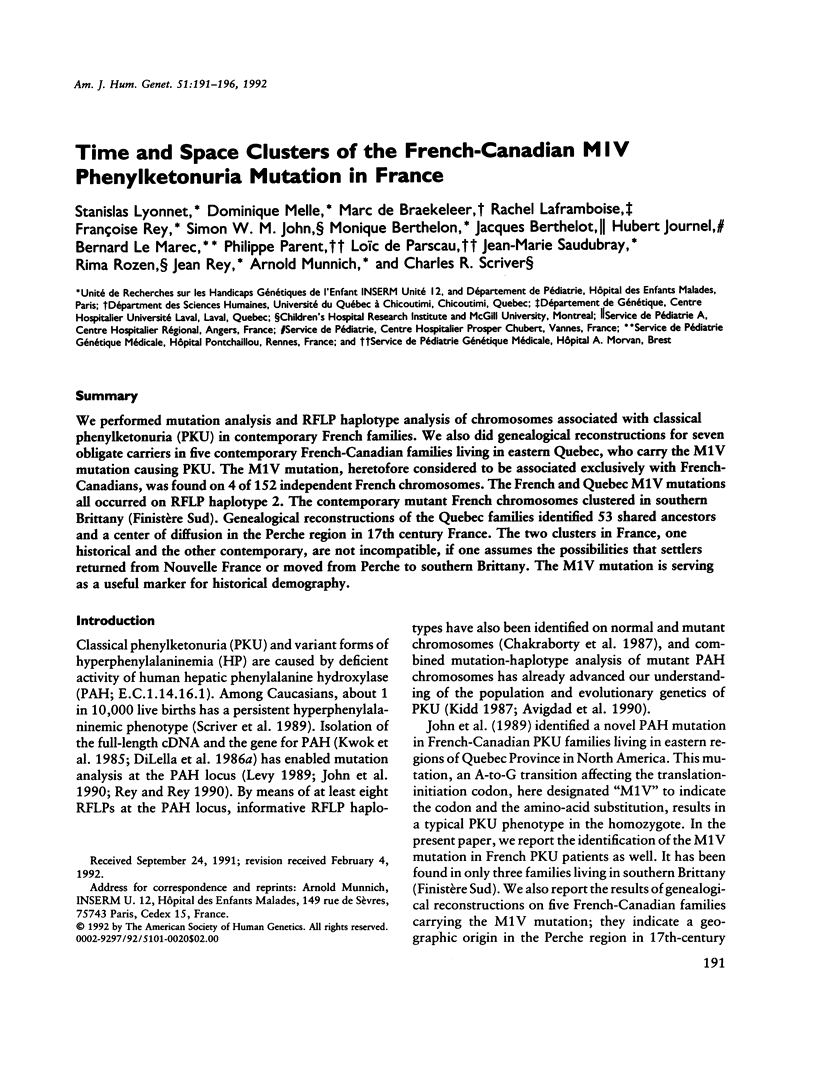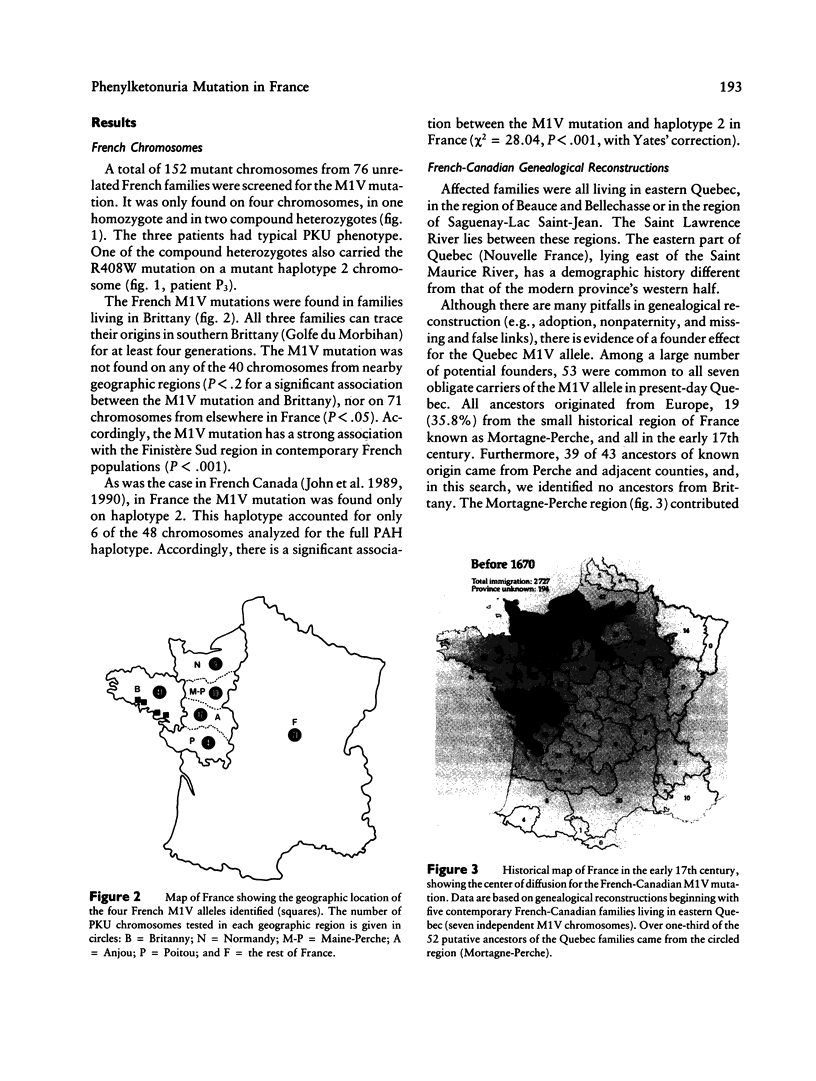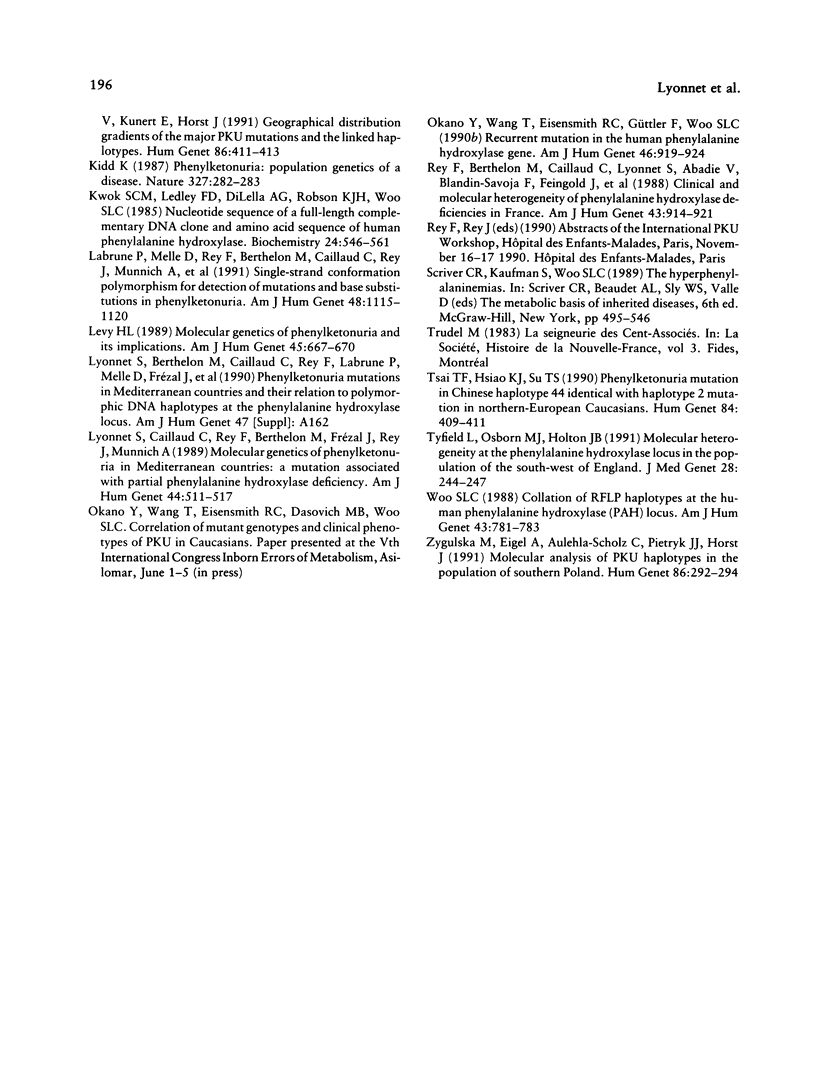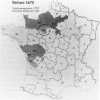Abstract
We performed mutation analysis and RFLP haplotype analysis of chromosomes associated with classical phenylketonuria (PKU) in contemporary French families. We also did genealogical reconstructions for seven obligate carriers in five contemporary French-Canadian families living in eastern Quebec, who carry the M1V mutation causing PKU. The M1V mutation, heretofore considered to be associated exclusively with French-Canadians, was found on 4 of 152 independent French chromosomes. The French and Quebec M1V mutations all occurred on RFLP haplotype 2. The contemporary mutant French chromosomes clustered in southern Brittany (Finistère Sud). Genealogical reconstructions of the Quebec families identified 53 shared ancestors and a center of diffusion in the Perche region in 17th century France. The two clusters in France, one historical and the other contemporary, are not incompatible, if one assumes the possibilities that settlers returned from Nouvelle France or moved from Perche to southern Brittany. The M1V mutation is serving as a useful marker for historical demography.
Full text
PDF





Images in this article
Selected References
These references are in PubMed. This may not be the complete list of references from this article.
- Abadie V., Lyonnet S., Maurin N., Berthelon M., Caillaud C., Giraud F., Mattei J. F., Rey J., Rey F., Munnich A. CpG dinucleotides are mutation hot spots in phenylketonuria. Genomics. 1989 Nov;5(4):936–939. doi: 10.1016/0888-7543(89)90137-7. [DOI] [PubMed] [Google Scholar]
- Avigad S., Cohen B. E., Bauer S., Schwartz G., Frydman M., Woo S. L., Niny Y., Shiloh Y. A single origin of phenylketonuria in Yemenite Jews. Nature. 1990 Mar 8;344(6262):168–170. doi: 10.1038/344168a0. [DOI] [PubMed] [Google Scholar]
- Berthelon M., Caillaud C., Rey F., Labrune P., Melle D., Feingold J., Frézal J., Briard M. L., Farriaux J. P., Guibaud P. Spectrum of phenylketonuria mutations in western Europe and north Africa, and their relation to polymorphic DNA haplotypes at the phenylalanine hydroxylase locus. Hum Genet. 1991 Feb;86(4):355–358. doi: 10.1007/BF00201832. [DOI] [PubMed] [Google Scholar]
- Boleda M. Les migrations au Canada sous le regime francais (1608-1760) Cah Que Demogr. 1984 Apr;13(1):23–39. [PubMed] [Google Scholar]
- Caillaud C., Lyonnet S., Rey F., Melle D., Frebourg T., Berthelon M., Vilarinho L., Vaz Osorio R., Rey J., Munnich A. A 3-base pair in-frame deletion of the phenylalanine hydroxylase gene results in a kinetic variant of phenylketonuria. J Biol Chem. 1991 May 25;266(15):9351–9354. [PubMed] [Google Scholar]
- Chakraborty R., Lidsky A. S., Daiger S. P., Güttler F., Sullivan S., Dilella A. G., Woo S. L. Polymorphic DNA haplotypes at the human phenylalanine hydroxylase locus and their relationship with phenylketonuria. Hum Genet. 1987 May;76(1):40–46. doi: 10.1007/BF00283048. [DOI] [PubMed] [Google Scholar]
- De Braekeleer M., Dionne C., Gagné C., Julien P., Brun D., Ven Murthy M. R., Lupien P. J. Founder effect in familial hyperchylomicronemia among French Canadians of Quebec. Hum Hered. 1991;41(3):168–173. doi: 10.1159/000153996. [DOI] [PubMed] [Google Scholar]
- DiLella A. G., Kwok S. C., Ledley F. D., Marvit J., Woo S. L. Molecular structure and polymorphic map of the human phenylalanine hydroxylase gene. Biochemistry. 1986 Feb 25;25(4):743–749. doi: 10.1021/bi00352a001. [DOI] [PubMed] [Google Scholar]
- DiLella A. G., Marvit J., Brayton K., Woo S. L. An amino-acid substitution involved in phenylketonuria is in linkage disequilibrium with DNA haplotype 2. 1987 May 28-Jun 3Nature. 327(6120):333–336. doi: 10.1038/327333a0. [DOI] [PubMed] [Google Scholar]
- DiLella A. G., Marvit J., Lidsky A. S., Güttler F., Woo S. L. Tight linkage between a splicing mutation and a specific DNA haplotype in phenylketonuria. 1986 Aug 28-Sep 3Nature. 322(6082):799–803. doi: 10.1038/322799a0. [DOI] [PubMed] [Google Scholar]
- Jaruzelska J., Henriksen K. F., Güttler F., Riess O., Borski K., Blin N., Slomski R. The codon 408 mutation associated with haplotype 2 is predominant in Polish families with phenylketonuria. Hum Genet. 1991 Jan;86(3):247–250. doi: 10.1007/BF00202402. [DOI] [PubMed] [Google Scholar]
- John S. W., Rozen R., Laframboise R., Laberge C., Scriver C. R. Novel PKU mutation on haplotype 2 in French-Canadians. Am J Hum Genet. 1989 Dec;45(6):905–909. [PMC free article] [PubMed] [Google Scholar]
- John S. W., Rozen R., Scriver C. R., Laframboise R., Laberge C. Recurrent mutation, gene conversion, or recombination at the human phenylalanine hydroxylase locus: evidence in French-Canadians and a catalog of mutations. Am J Hum Genet. 1990 May;46(5):970–974. [PMC free article] [PubMed] [Google Scholar]
- Kalaydjieva L., Dworniczak B., Kucinskas V., Yurgeliavicius V., Kunert E., Horst J. Geographical distribution gradients of the major PKU mutations and the linked haplotypes. Hum Genet. 1991 Feb;86(4):411–413. doi: 10.1007/BF00201847. [DOI] [PubMed] [Google Scholar]
- Kidd K. K. Phenylketonuria. Population genetics of a disease. 1987 May 28-Jun 3Nature. 327(6120):282–283. doi: 10.1038/327282a0. [DOI] [PubMed] [Google Scholar]
- Kwok S. C., Ledley F. D., DiLella A. G., Robson K. J., Woo S. L. Nucleotide sequence of a full-length complementary DNA clone and amino acid sequence of human phenylalanine hydroxylase. Biochemistry. 1985 Jan 29;24(3):556–561. doi: 10.1021/bi00324a002. [DOI] [PubMed] [Google Scholar]
- Labrune P., Melle D., Rey F., Berthelon M., Caillaud C., Rey J., Munnich A., Lyonnet S. Single-strand conformation polymorphism for detection of mutations and base substitutions in phenylketonuria. Am J Hum Genet. 1991 Jun;48(6):1115–1120. [PMC free article] [PubMed] [Google Scholar]
- Levy H. L. Molecular genetics of phenylketonuria and its implications. Am J Hum Genet. 1989 Nov;45(5):667–670. [PMC free article] [PubMed] [Google Scholar]
- Lyonnet S., Caillaud C., Rey F., Berthelon M., Frézal J., Rey J., Munnich A. Molecular genetics of phenylketonuria in Mediterranean countries: a mutation associated with partial phenylalanine hydroxylase deficiency. Am J Hum Genet. 1989 Apr;44(4):511–517. [PMC free article] [PubMed] [Google Scholar]
- Rey F., Berthelon M., Caillaud C., Lyonnet S., Abadie V., Blandin-Savoja F., Feingold J., Saudubray J. M., Frézal J., Munnich A. Clinical and molecular heterogeneity of phenylalanine hydroxylase deficiencies in France. Am J Hum Genet. 1988 Dec;43(6):914–921. [PMC free article] [PubMed] [Google Scholar]
- Tsai T. F., Hsiao K. J., Su T. S. Phenylketonuria mutation in Chinese haplotype 44 identical with haplotype 2 mutation in northern-European Caucasians. Hum Genet. 1990 Apr;84(5):409–411. doi: 10.1007/BF00195810. [DOI] [PubMed] [Google Scholar]
- Tyfield L. A., Osborn M. J., Holton J. B. Molecular heterogeneity at the phenylalanine hydroxylase locus in the population of the south-west of England. J Med Genet. 1991 Apr;28(4):244–247. doi: 10.1136/jmg.28.4.244. [DOI] [PMC free article] [PubMed] [Google Scholar]
- Woo S. L. Collation of RFLP haplotypes at the human phenylalanine hydroxylase (PAH) locus. Am J Hum Genet. 1988 Nov;43(5):781–783. [PMC free article] [PubMed] [Google Scholar]
- Zygulska M., Eigel A., Aulehla-Scholz C., Pietrzyk J. J., Horst J. Molecular analysis of PKU haplotypes in the population of southern Poland. Hum Genet. 1991 Jan;86(3):292–294. doi: 10.1007/BF00202412. [DOI] [PubMed] [Google Scholar]




